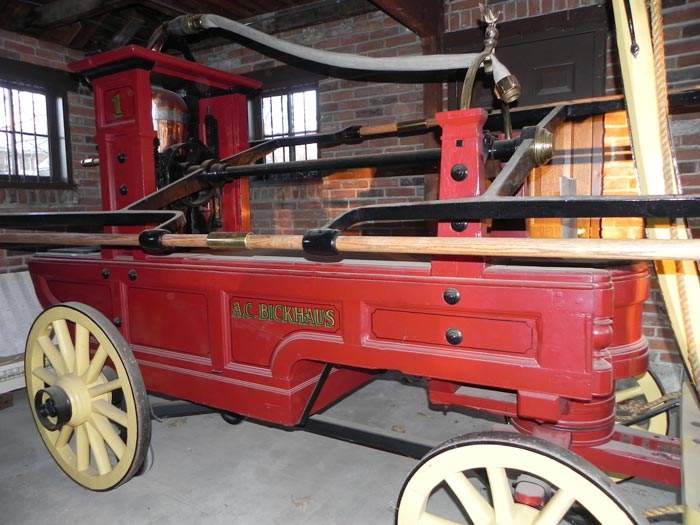'Where duty calls, you will find us!'

From 1825 when Quincy became the seat of Adams County through 1839, the population of the city grew from about 6 to 700 inhabitants. With this exponential growth, the risk of fire to the citizens and their property erupted like the flames. Quincy needed protection. Quincy needed firefighters.
Quincy’s approximately 63 firefighters today started as a small band of volunteers in what was then an unincorporated, frontier river town. The boundaries of Quincy extended west to east from the river to 8th Street (12th Street in some places) and north to south from Oak to York Streets. Quincy’s founder and later governor John Wood and Joel Rice, another early Quincy settler, were appointed in 1838 to plan improvements “to protect the community from the ravages of fire,” according to early Quincy historian Gen. John Tillson.
Later that year, the town purchased four ladders, six hooks and one dozen buckets. The Quincy Fire Department was taking shape, although the town would not be incorporated as a city until 1840. When fires occurred, the “bucket brigade” would leap into action by forming a line from one of a series of private and public cisterns (underground tanks for storing water) throughout the town to the place of the fire. They literally handed buckets full of water up the line and then empties back down the line for refilling. The buckets were often made of cowhide. A bucket from Fire Company Number 6, which would be much like those early buckets, can be viewed in the Gov. John Wood Mansion at 12th and State.
Wood was one of the early volunteers for Fire Company Number 1, according to the company’s minute book that is part of the collection of the Historical Society of Quincy and Adams County.
The town fathers determined in 1839 that the bucket brigades needed help. They purchased the town’s first hand-pump fire engine for $1,124.58 (which would be about $27,000 in today’s dollars). It was a goose-neck, New York-style, sidestroke, hand-pulled and hand-pumped fire engine, manufactured by the James Smith Company. It could pump between 100 and 150 gallons of water per minute, depending on the number of strokes. The engine became known as “Old Quincy Number 1” and sometime later was renamed “Rough and Ready” or “Ready and Willing,” depending on the source. It was inscribed with the motto “Where Duty Calls You Will Find Us!” Old Quincy Number 1 served Quincy until 1869, when it was sold to Shelbina for $500.
Quincy was transitioning to steam-powered fire engines. However, nostalgia inspired the Firemen’s Benevolent Association to repurchase the engine in 1892 for $75. It was renamed sometime thereafter the “A.C. Bickhaus” in honor of Bickhaus, who was a volunteer fireman, city alderman and fire commission chairman.
Upon its return to Quincy, Old Quincy Number 1 became a showpiece and was used little in firefighting. The engine was restored by a Quincy businessman in 1996 and is now exhibited on the campus of the Historical Society at 12th and State.
Quincy’s early firefighters also needed protection, but today’s Nomex and Kevlar materials were not available. They wore helmets made of wood or possibly leather or paper mache’. Some accounts refer to the helmets as “glazed caps.” The purpose of the helmets was not so much to shield them from fire but instead to protect them from hot water. Pictured above is a fireman’s hat from Quincy’s Marion Hose Company. “Marion” was the name of Quincy’s second hand-pump engine, which was acquired in late 1839.
In the late 1840s, the rest of the clothing consisted of white pants without suspenders, a black cravat (tie), and a black belt. A fire cape had been recommended in March 1840 to the fi re company’s governing committee but was rejected.
By 1866, Quincy started introducing steam engines into its fleet, and Quincy’s first firefighters and their then antiquated equipment faded. For the next more than 150 years the department continued to grow and modernize.
Today, the Quincy Fire Department has five engine houses, approximately 10 rescue vehicles, and responds to between 3,500 and 4,000 emergency situations annually throughout Quincy.
Hal Oakley is a lawyer with Schmiedeskamp, Robertson, Neu & Mitchell LLP and a civic volunteer. He has authored several legal articles and edited, compiled and/or contributed to books and articles on local history.
Sources
Cray, Marcia Kuhlman. "156 Years of Smoke, Sweat & Courage – The History of the Quincy Fire Department" (1996).
"Minutes of Fire Company No. 1, 1839-1861." Historical Society of Quincy and Adams County, Quincy, Illinois.
Quincy Herald. Passim.
Quincy Whig. Passim.
Tillson, General John. History of the City of Quincy. In Collins, William H. and Cicero F. Perry, Past and Present of the City of Quincy and Adams County, Illinois. Chicago: S.J. Clarke, 1905.






